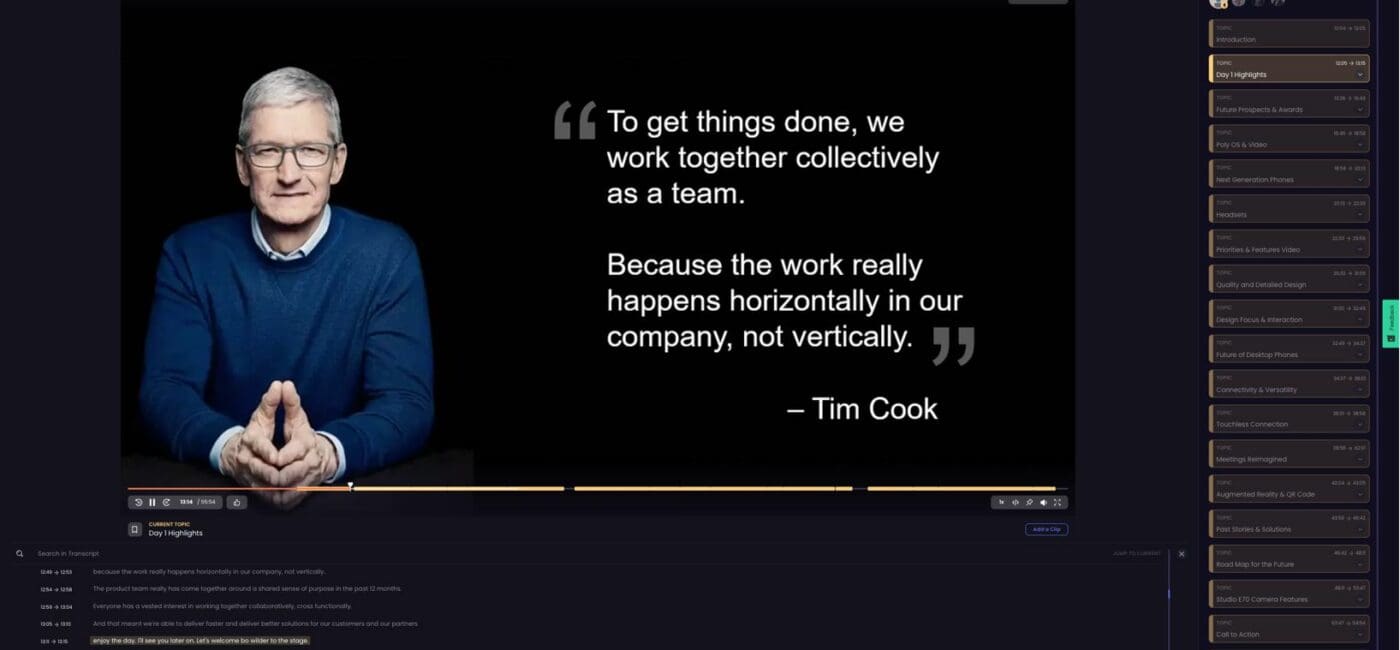8.18.21 – CI- Alyssa Borelli
Real-time optional saves time so you’re not being held captive in an hour-long video conference where you can’t look away.

I’ll admit, I’ll sign up for virtual webinars with no intention of attending on the scheduled date. I’ll wait for the recording to land in my inbox, where it will sit — for days. I’m sure some of our readers are guilty of it, too.
Skimming the auto-generated transcript may save time, but the inner editor in me wants to correct it, but can’t, so I’ll end up fast forwarding bits and pieces of the recording, and hope I get the gist of what I signed up for.
What if there was a solution that saved us time and only took us to the good parts of the webinar or meeting? I had the pleasure of interviewing Humphrey Chen, CEO & Founder of CLIPr for “Preparing For a Remote-First Future…Without Getting Fatigued,” who created a platform which I think a lot of us could use, and need right now in this post-pandemic hybrid workplace model that’s going on now.
CLIPr uses AI and machine learning to create an outline of a presentation, where it can index, auto transcribe, and where you can even search for the keywords from a meeting that you are looking for. It’s almost as if you were in the meeting but weren’t there physically.
Instead of being required to attend a meeting, what if there was a check box option to make it “real-time optional,” which is what CLIPr is trying to do. Real-time optional saves time so you’re not being held captive in an hour-long video conference where you can’t look away. Instead, you can use that time to focus on your own deliverables and catch up on what you missed later.
Video Fatigue is Real
All these virtual meetings are making us fatigued. As social distancing protocols kept us apart physically, virtual meetings have skyrocketed and some experts predict hybrid work is here to stay. Studies at Stanford and Microsoft have proved Zoom fatigue is real.
Stanford’s Virtual Human Interactions Lab (VHIL) examined the psychological consequences of spending hours per day on video conferencing platforms and found four reasons as to why it is making us fatigued:
Excessive amounts of close-up eye contact is intense
The amount of eye contact in virtual meetings is dramatically increased compared to a normal meeting, where one can be looking at the speaker, taking notes, or looking elsewhere. On Zoom calls, everyone is look at the everyone, at the same time.
“Social anxiety of public speaking is one of the biggest phobias that exists in our population,” said professor Jeremy Bailenson, founding director of VHIL, in blog post. “When you’re standing up there and everybody’s staring at you, that’s a stressful experience.”
Seeing yourself during video chats constantly in real-time is fatiguing
Most video platforms show a square of what you look on camera during a chat. Bailenson compared to the real-world — it would be like someone following you around with a mirror, and nobody would consider that. Bailenson also noted studies when you see yourself, you are more critical of yourself, contributing to negative emotional consequences.
Video chats reduce mobility
Most cameras have a field of view, which does not allow the ease of walking around and moving. Movement is very limited and is unnatural when you’re held captive in video meetings. “There’s a growing research now that says when people are moving, they’re performing better cognitively,” says Bailenson.
The cognitive load is much higher in video chats
Our brains must work harder to process video meetings. In regular face-to-face interactions, nonverbal communication is natural and subconsciously interpreted. On video calls, one must try to interpret the speakers’ nonverbal cues. In person, a side glance could mean something completely different compared to a side glance in a video chat look off-screen, perhaps at a cat who just walked into the home office.
The Real-Time Optional Solution to Video Fatigue
As video becomes a predominant vehicle in which we communicate, the fatigue that comes along with it is inevitable. There’s no one clear solution to fatigue, but there are steps one can take, such as taking breaks often, limiting meetings to shorter time frames, and the 20/20 rules.
Bailenson recommends changes to the platforms that make it more natural, such as screen size. In the real-world being up close and personal to someone else, can be viewed as a threat. Taking Zoom out of the full-screen option and reducing the size face size can help.
Regardless, in-person office meetings may become a thing of the past. In-person meetings are going to be more selective.
Time is a precious asset, which we must invest in wisely. If we don’t have to sit through hours upon hours of virtual meetings each week, imagine how time we’ll save by being real-time optional.
